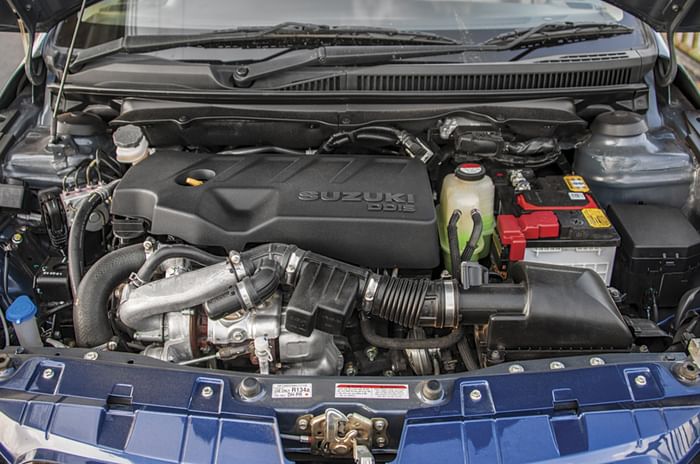The Maruti Suzuki Ciaz 1.5-litre diesel made a great first impression when we drove it a few months ago. This time round, we’ve put it through our exhaustive road test to find out how it performs in the real world, and since we’ve reviewed the Ciaz several times in the past, we’ll focus only on its new diesel engine.
Codenamed E15A, this 1,498cc, four-cylinder engine is Maruti’s second attempt at a diesel; the first was the (E08A) 793cc, two-cylinder unit in the Celerio. This 1.5-litre engine is essentially the sum of two Celerio diesel blocks put together, but with heavy modifications. Its stroke has been shortened from 85.1mm to 80.4mm, lowering the cubic capacity to under 1,500cc, so that it can be used in smaller cars in the future and still fall under the lower tax structure. The combustion chamber, valve gear, and the intake and exhaust manifolds have been revised too.

Compare this engine’s specs to the Fiat-sourced 1.3-litre unit, and despite being 20 percent larger in capacity, power and torque are up by just 5hp and 25Nm, respectively, which appear a bit underwhelming on paper. One of the key reasons for this is its modest 15.8:1 compression ratio (the 1.3 diesel’s is 17.6:1). In theory, a higher compression ratio leads to better thermal efficiency, resulting in better power and fuel efficiency, but the benefits of a lower compression ratio are many. For starters, due to lesser stress on its internals, it’s possible to have a lighter yet more rigid aluminum block with cast-iron sleeves, thus shaving off some weight – the 1.5 Ciaz is 20kg lighter than the 1.3 SHVS car. Another benefit is lower NOx emissions; still, it doesn’t comply to BS6 standards just yet.
This unit is a far cry from the gruff and clattery Fiat-sourced 1.3 diesel. Refinement levels are so good and it feels so smooth and quiet, it’s one of the best in the segment. Be it at idle or on the move, engine noise is minimal, and at no point does it sound crude or unrefined. It also gets a dual-mass flywheel, which, although an expensive addition, does a remarkable job of ironing out vibrations. Ambient sounds and road noise, however, aren’t as well controlled, and this dulls the otherwise refined experience.

Being a larger displacement engine, the initial responsiveness is better than the 1.3 diesel’s so it doesn’t feel completely dead below 1,700rpm. It’ll keep up with traffic even off boost in the first three gears,but will warrant a downshift to dart into gaps. Out on the open road, turbo lag is most prominent below 1,700rpm, especially in the top three overdrive gears; so it needs to be kept on the boil to deliver its best. Spin it beyond 2,000rpm and a strong surge of torque lunges this car forward. Those who enjoy driving will love its wide powerband and free-revving nature, and what’s nice is that performance remains strong until the 5,200rpm redline. The healthy mid- and top-end performance makes overtaking fast-moving traffic effortless, and the Ciaz feels at ease while cruising. Acceleration timings are quick by diesel sedan standards; it manages a 0-100kph sprint in 11.50sec, clocking impressive in-gear timings too. However, the Verna 1.6 diesel still remains the car to beat when it comes to outright acceleration.
The 1.5 diesel Ciaz sets a new benchmark among sedans when it comes to fuel efficiency. Despite not having a mild-hybrid system (present in the 1.3L version), this car achieved a staggering 17.15kpl in the city and 20.59kpl on the highway, averaging 18.87kpl. To put things into perspective, the super-efficient Celerio diesel, that’s 225kg lighter than the Ciaz, averaged 18.8kpl. The Ciaz’ tall gearing ensures that it is an easy sipper; for reference, it will spin at a lazy 1,900rpm in sixth and 2,200rpm in fifth gear, while cruising at 100kph. Another modern Maruti trait is that the air-con compressor kicks in and out every few seconds,and the tachometer shuttles between 700rpm and 900rpm to reduce fuel consumption while idling.

Mated to this engine is a light and smooth-to-use 6-speed manual; its lever is a bit tall and the gates aren’t as well-defined as the 1.3L’s 5-speed unit. There isn’t any perceptible difference in terms of ride and handling or braking, and the Ciaz does its job in a benign, unexciting manner.

The Ciaz may not feel as solid as some of its competitors. It lacks some premium features like a sunroof, and the cabin isn’t as nicely insulated as its rivals, but then, it has proven itself and it delivers everything buyers are looking for – space, comfort and value for money. And the new 1.5 diesel is a gem of an engine – one of the best in its class in terms of refinement and smoothness. And true to its DNA, it is incredibly fuel-efficient as well. This diesel engine is a perfect replacement for the now-dated Fiat-sourced unit, and with it, the Ciaz has become an even more compelling package than it already was.
Click here for Maruti Suzuki Ciaz prices, reviews, images, videos and more
Click here for Maruti Suzuki models, prices, reviews, images, videos and more




































